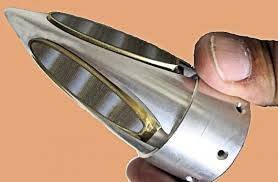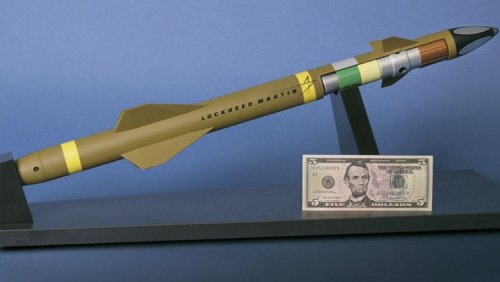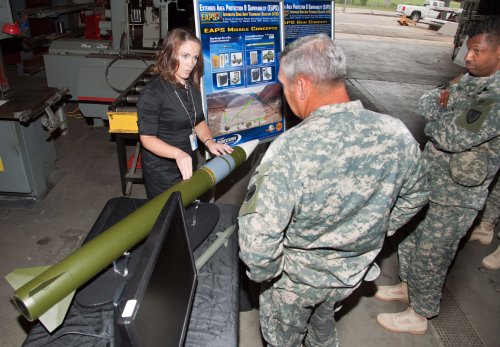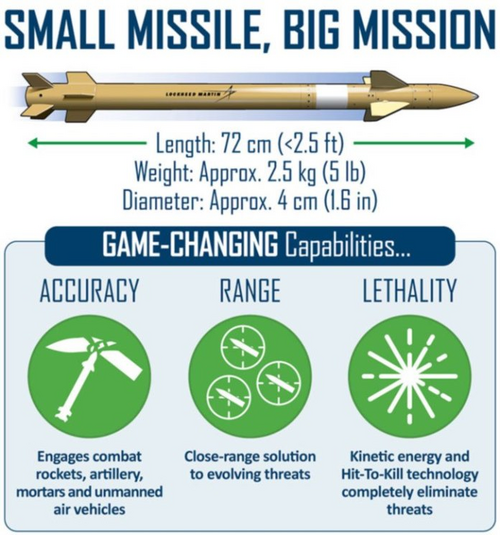Lockheed eyes opportunities for MHTK
Robin Hughes, London - IHS Jane's Missiles & Rockets
20 July 2015
Lockheed Martin's MHTK interceptor. Source: Lockheed Martin
Key Points
Three guidance options are available for the MHTK interceptor, plus an option for miniature warhead integration
Future options for the EAPS competitor include equipping helicopters, UAS and potentially offering a shoulder-launched capability
Lockheed Martin is expecting to complete development of its miniature hit-to-kill (MHTK) kinetic interceptor for the US Army's Extended Area Protection and Survivability Integration Demonstration (EAPS ID) programme by August/September 2016, with a view to exploiting the MHTK technology for other opportunities.
Lockheed Martin and Northrop Grumman were awarded multi-phase contracts in February 2008, aiming to design and demonstrate a prototype missile interceptor weapon system for the EAPS ID programme.
The latter is a Science & Technology programme designed to advance the development of critical intercept technologies to meet a future US Army requirement for enhanced counter rocket, artillery, and mortar (C-RAM) and counter-unmanned aerial vehicles (C-UAV) roles.
EAPS ID is expected to inform the Army Cruise Missile Defense Systems (CMDS) programme office's decision on what technologies to progress as it draws up plans for its future Indirect Fire Protection Capability, Increment 2 - Intercept (IFPC Inc 2-I) Block 2 requirement.
The IFPC Inc 2-I is envisaged as a tactical ground-based weapon system designed to acquire, track, engage, and defeat UAVs, cruise missiles (CM), and RAM threats. The CMDS office intends to apply a block acquisition approach to provide the IFPC Inc 2-I capability. Block 1 will deliver point protection for C-UAV and CM Defence (CMD), elements of this Block include: developing the Multi-Mission Launcher (MML); and leveraging existing interceptors (AIM-9 type), sensors (Sentinel), and existing network (Integrated Battle Command System: IBCS). Block 2 adds a C-RAM capability, including leveraging the MML and the IBCS, as well as developing a new sensor or extending the capabilities of an existing sensor to support C-RAM engagements and developing a C-RAM interceptor.
Block 3 extends the Block 1 CUAS/CMD capability from point defence to area defence.
Chris Murphy, Lockheed Martin Missiles & Fire Control business development lead for MHTK told IHS Jane's that in the near term the company will complete some rescheduled lethality and flight tests by September 2016, and transition MHTK off the EAPS programme to position it for the IFPC Inc 2-I Block 2 requirement.
Lockheed Martin conducted Controlled Test Vehicle flight tests in May 2012, followed by an initial guided flight test in March 2013, and a guided intercept test in January 2014 to characterise the performance of the RF seeker. Follow-on tests scheduled for August 2014 were postponed due to "challenges with the seeker", but the company asserts that these have since been resolved.
The MHTK is understood to be approximately 70 cm (29 inches) in length and 4 cm in diameter, with a launch weight of about 2.5 kg. Lockheed said that "MHTK's effective range [for a single-shot kill] against RAM will be 3 km or more."
While there are no energetics in the missile - as the name suggests it is a body-to-body contact kill system - Lockheed Martin has integrated a 'lethality mechanism' or penetrator package in the MHTK to help penetrate the skin of the target. Murphy noted that "the precision and accuracy that go with hit to kill allow us, if required, to remove the penetrator package and integrate a small warhead, to achieve the effect desired without extensive collateral damage, and this is something that could be explored."
Lockheed Martin has integrated unique amorphous alloy canards, sourced from Liquidmetal Technologies, for the MHTK. To achieve the miniaturised electronics package for the interceptor, Lockheed Martin has sourced a range of technologies for components and packaging from outside of its customary supply chain.
"We've borrowed from the medical imaging industry, from the cell phone industry, and from 'large data farming' industries; we've also leveraged some unique packaging industries to fit the electronics, the batteries, to fit the controllers, the motor and to fit the elements of the seeker into the missile."
Murphy said that Lockheed Martin will offer three guidance options for MHTK: it initially integrated a semi-active RF seeker, which was the main focus of the EAPS programme; the US Army's Aviation and Missile Research, Development and Engineering Center (AMRDEC) funded a feasibility investigation of an active seeker in the same form factor.
Lockheed Martin is continuing this work on internal investment and has had some success, although it is not as mature as the semi-active RF seeker development.
The company is also evaluating integration of a semi-active laser (SAL) for use with a third-party designator source. "We designed and built the missile so that we could interchange guidance options; if we wanted to integrate a miniaturised video camera in the front end, and it made sense to do so, we are also able to that."
The interceptor itself is powered by a compact new rocket motor developed by Nammo in the United States. Nammo said the MHTK's narrow 40 mm diameter interceptor body precluded the requirement for any active cooling or heating, ventilating, and air-conditioning devices; its solution focuses on mechanical design innovations combined with the development of a new propellant, and materials able to withstand sustained heat. Nammo declined to disclose the exact compositions used, but said that the kinematic requirements needed a very fast burning propellant that is required "to burn for seconds".
To meet the proposed IFPC Inc 2-I Block 2 architecture, Lockheed Martin will package multiple MHTKs in an all-up round (comprising the missiles and the canister they are launched from). The all-up round fits a single launch tube of the MML and can be shipped in the same canister assembly, thus delivering the missile loadout required by the army, but also minimising the missile's logistics footprint.
For other C-RAM user requirements, multiple MHTK all-up rounds canisters can be 'ganged' into any launch tube, with the only limitations being the: size of the launch tube, the availability of an adequate power supply.
Murphy confirmed that Lockheed Martin is already in discussions with two international customers with regard to acquiring the interceptor for a C-RAM/C-UAV requirement.








